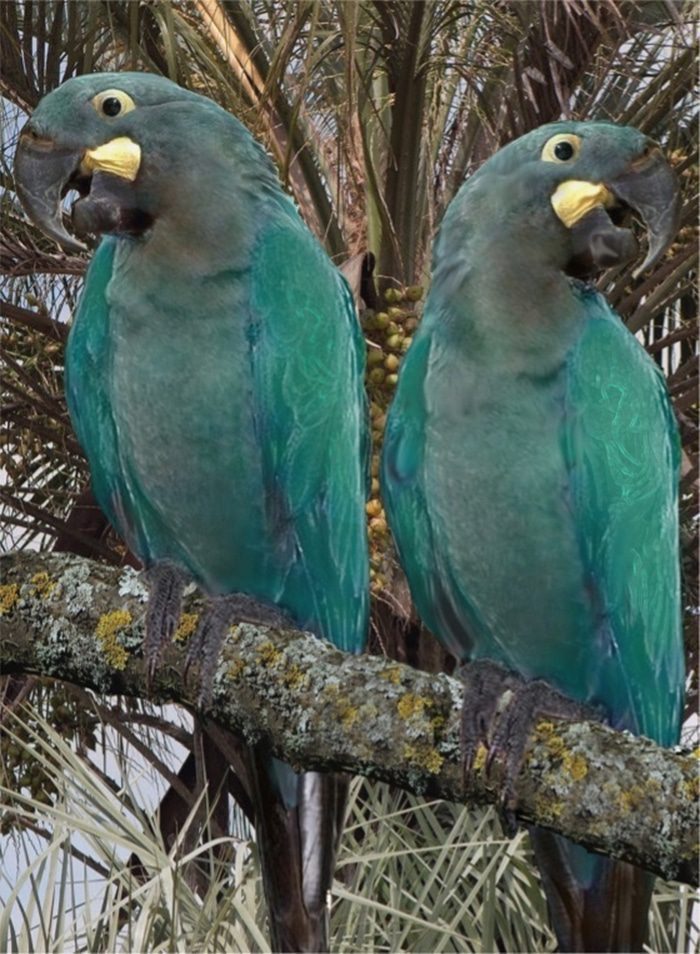Content |
|---|
Description:
72 cm.. length.
The plumage general of the Glaucous Macaw (Anodorhynchus glaucus) It is light blue, almost turquoise top, with strong grayish hue in head and underparts.
Uppertail greenish blue; undertail gray.
The bill It is dark blackish gray, the naked flames in the base lower jaw they are yellow, but paler than the periophthalmic skin; the irises is dark brown, the periophthalmic skin Nude yellow; the legs They are dark.
Habitat:
probably he occupied subtropical gallery forests with cliffs, but also used lightly wooded savannas and rich in palm trees. The few contemporary records suggest it was naturalists gregarious.
Reproduction:
It has been reported that anidaba on steep slopes or cliffs, or less generally in the cavities of trees and the average size of laying It was probably two eggs
Food:
Its diet It was probably basic nuts palm Butia horizontal (nearest equivalent in rank to size nuts Syagrus used by the Indigo Macaw, It is having the same dimensions peak).
Distribution:
Extending its range (breeding/resident): 1 km2
the Glaucous Macaw They were distributed at the time by the south-eastern South America, where apparently they were recorded in average growth of the main rivers, including Parana River, the Uruguay River and the Paraguay River, with most of the evidence of a prior distribution in the province of Currents, to the North of Argentina; cases were also recorded in western Uruguay and Southeast of Brazil (Rio Grande do Sul and Paraná), and evidently in the south and east of Paraguay. The records of Bolivia They seem wrong. Almost certainly extinct after a precipitous decline in the early 19th century. Only two records in the twentieth century.
Conservation:
• Current category of the Red List of the UICN: Critically Endangered.
• Population trend: Unknown.
• Population size : 1-49 individuals.
Rationale for the Red List category
This species was last recorded in the 1990s. 1960 and it is likely that its population has declined dramatically as a result of hunt, Besides the degradation and habitat destruction. But, you may still exist, since not all its wide range of data, above wide, It has been adequately studied, and there have been persistent and convincing local reports. Any remaining population is likely to be small., and for these reasons it is treated as in Critically Endangered.
Justification of the population
It is assumed that any remaining population is small (counting less than 50 individuals) due to lack of confirmed records since the early 1960.
Threats
The settlement of the major river basins within its range was allegedly accompanied by the widespread loss of palms, whether by direct cleaning for agriculture or suppression of regeneration by livestock settlers. The palma de Horizontal, of the species probably fed, It was chosen to be cleared by early settlers because it was an indicator of good soil quality (Necklace et to the. 2014). The widespread loss of gallery forests could also have had an impact on the species. (Necklace et to the. 2014). The size and appearance of the bird probably made him a prime target for hunters, and even capture hatchlings as pets could have been important. There is some evidence that were sold, but few to support various claims that there has been recent trade in live specimens.
Any current trade in eggs, skins or live specimens would obviously be extremely damaging.
Conservation actions underway
-
– Appendix I of CITES and protected by Brazilian law.
– There have been several attempts (so far unsuccessful) to rediscover the species.
– There are proposals for funding under way to try to fund a work program to confirm the presence of this species in the wild.
Conservation Actions Proposed
-
– Conducting interviews with the local population, especially with parrots and ancient hunters assets, to assess the likelihood of any population remains.
– Getting ready to follow up any positive data from these interviews.
"Glaucous macaw †" in captivity:
There is some evidence that were sold, but few to support various claims that there has been recent trade in live specimens.
Alternative names:
– Glaucous Macaw (inglés).
– Ara glauque (francés).
– Türkisara (alemán).
– arara-azul-pequena, arara-celeste, guacamaio (portugués).
– Guacamayo Azul, Guacamayo Glauco, Guacamayo Violáceo, Papagayo violáceo (español).
– Guacamayo azul (Argentina).
– Papagayo violáceo (Paraguay).
– Guacamayo Azul (Uruguay).
scientific classification:
– Order: Psittaciformes
– Family: Psittacidae
– Genus: Anodorhynchus
– Scientific name: Anodorhynchus glaucus
– Citation: (Vieillot, 1816)
– Protonimo: Macrocercus glaucus
Images Glaucous Macaw:
“Glaucous Macaw” (Anodorhynchus glaucus)
Sources:
– Avibase
– Parrots of the World – Forshaw Joseph M
– Parrots A Guide to the Parrots of the World – Tony Juniper & Mike Parr
– Birdlife
– Photos:
(1) – digital recreation of glaucous macaw. The background with Butia yatay is courtesy of http://floradeluruguay.blogspot.com/2010/05/butia-yatay.html , Andrés González. By Rod6807 (Martin Rodríguez Pontes) (Own work) [CC BY-SA 3.0], via Wikimedia Commons
(2) – Anodorhynchus glaucus by Huub Veldhuijzen van Zanten / Naturalis Biodiversity Center [CC BY-SA 3.0], via Wikimedia Commons
(3) – Anodorhynchus glaucus by Huub Veldhuijzen van Zanten / Naturalis Biodiversity Center [CC BY-SA 3.0], via Wikimedia Commons
(4) – Anodorhynchus glaucus By Vieillot, 1816 [CC BY-SA 3.0], via Wikimedia Commons
(5) – Anodorhynchus glaucus by Huub Veldhuijzen van Zanten / Naturalis Biodiversity Center [CC BY-SA 3.0], via Wikimedia Commons
(6) – Early illustration of the Glaucous Macaw illustration from Bourjot Saint-Hilaire, 1837-1838 By Bourjot Saint-Hilaire [Public domain], via Wikimedia Commons







and it really does exist I've seen it in the florida river in the middle of the iguaçu reserve a very small river I found some photos that prove its existence